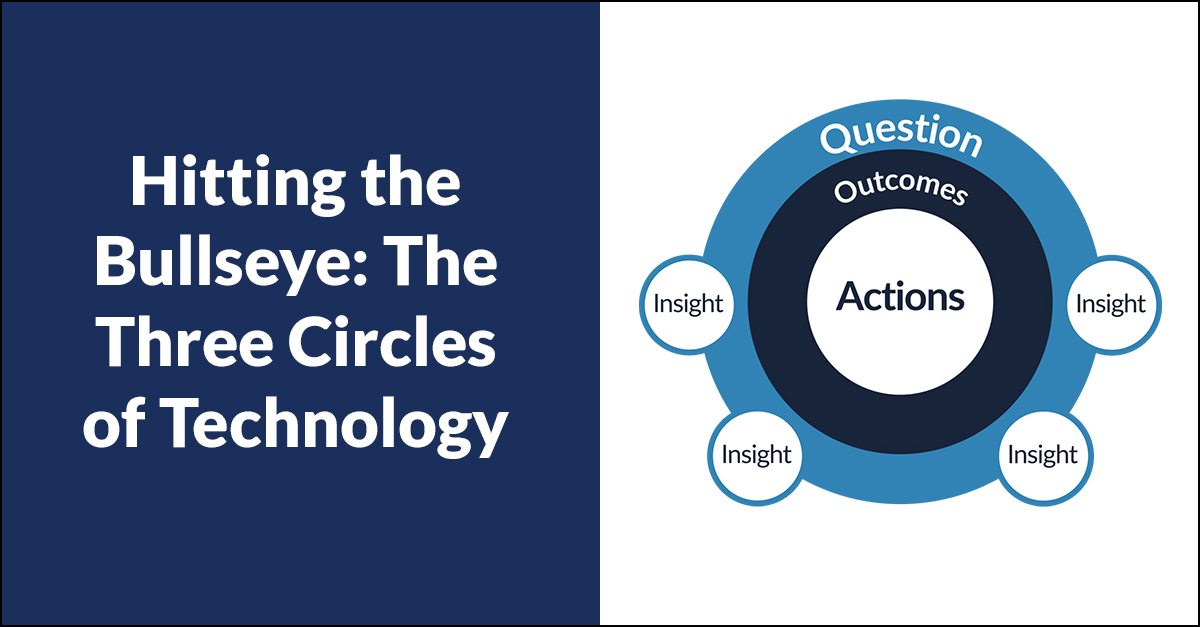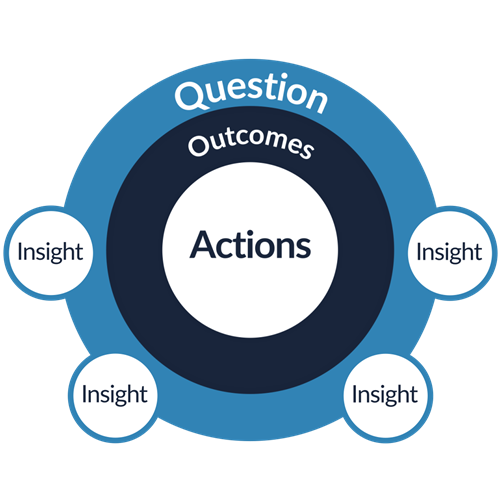
Solving a complex business problem often relies on breaking it down to truly understand the core question at the center of the problem. How do you make sure you set you and your team up for problem-solving success?
Before you start to solve the problem, you have to identify it—find the right angle to tackle the problem or answer a defining question. At Far Reach, we use the three circles method to help our clients navigate technology and process problems
with laser focus.
When used properly, the three circles method can serve as a framework that facilitates problem-solving across your organization and fuels continuous improvement. Perhaps the most interesting and significant outcome is trimming away useless fat from complex issues and simplifying concepts in a way
that makes them much easier to solve.
Let’s see it in action.
The Three Circles Method: Question, Outcomes, Action
As the name suggests, this problem-solving methodology can be illustrated with three circles, one laid inside of another.

From the outside to the inside, these circles are:
1. Question
The first and largest circle, which envelops the other two circles, is the most significant in your quest to address the issue at hand. Getting this early stage right sets you up for success with the subsequent circles.
Within this first circle, it’s about getting to the essence of the issue to find the crux of the problem. You can start with questions like:
- What is the problem we are trying to solve?
- What is the thing that’s preventing us from moving forward?
The answer should be equally simple, no more than a few words or a single sentence. For example: “Our core business software is old and inefficient” is a perfectly valid starting point.
Which takes us to the next circle:
2. Outcomes
In this stage, I encourage you to go as in-depth as possible. Identify the outcomes you expect (and want) to see from solving the problem.
Can you tie the outcomes to specific business goals? If so, that’s great. Make sure to work within your organization to see how solving the problem can have ramifications across departments.
Following up on the example above: What are the outcomes you can expect when you set out to upgrade your core business software? Or when you use that upgrade to move your paper processes to digital?
Possible outcomes could include:
- 25% lower client churn rate
- 50% less time spent migrating data from one solution to another manually
- 10% less team member churn and higher satisfaction
Not sure how to define your ideal outcomes? That’s OK—the data you need is there, you just have to find it. And from the data, you will discover insights that can help surface your desired outcomes.
You can start by looking at your P&L statements to identify areas that could be improved by solving the problem identified in step one. Outcomes go beyond revenue, however, so team member input can be very valuable. We use Officevibe to help keep a pulse on team member engagement and fulfillment.
Sometimes, though, you will need to look outside your company for answers. When you do so, start by taking another look at your customer persona and at the voice of the customer (VoC). Through an in-depth look at VoC, you can identify the areas your efforts should be focused on, which will influence the outcomes you
expect and desire.
Now that we have gathered all these valuable insights, we’re ready for the third and final step of our journey:
3. Action
The action circle is your game plan. Circles one and two have provided a better definition of the problem and the data and intel to allow you to solve it efficiently.
Now it’s time to put that solution on paper.
- How can you get the desired outcomes from circle two?
- What are the steps you need to take in order to check every box in the outcomes category?
The answers to these questions can initially be as simple as a sentence. Let’s focus on the same example: Dealing with an out-of-date software system.
The summary of your game plan can simply be: Determine the new tools that will meet current market and customer demands.
Of course, then you will have to get more granular:
- What are the goals of the new system?
- Will you develop in-house?
- Will you hire a software development partner like Far Reach?
- How long until your new system is fully functional and ready to produce results/ROI?
The nitty-gritty of it all will become clearer if the initial bricks are laid properly. If your question is valid, if your outcomes are tied to your business goals, and if your game plan is based on actionable items, you are well on your way to success.
Solving business problems is complex. There are thousands of books written about it, so we can’t possibly cover everything in a single blog post.
What we can do, though, is simplify complex issues and reduce them to bite-sized, easily solvable nuggets. This way, we don’t get lost in trivial matters that can hinder progress.
I love talking about problem-solving frameworks (and problem-solving
in general), so I’d love to hear your take on it.
Reach out if you’d like to talk
about it more or if you have a problem to dive into.